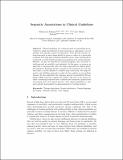Files in this item
Semantic annotations in clinical guidelines
Item metadata
| dc.contributor.author | Rahman, Fahrurrozi | |
| dc.contributor.author | Kuster Filipe Bowles, Juliana | |
| dc.contributor.editor | Bowles, Juliana | |
| dc.contributor.editor | Broccia, Giovanna | |
| dc.contributor.editor | Nanni, Mirco | |
| dc.date.accessioned | 2021-03-22T17:30:08Z | |
| dc.date.available | 2021-03-22T17:30:08Z | |
| dc.date.issued | 2021-03-05 | |
| dc.identifier | 272117064 | |
| dc.identifier | 5e174368-bf8c-4aba-b1f4-29a924a8f853 | |
| dc.identifier | 85103556106 | |
| dc.identifier.citation | Rahman , F & Kuster Filipe Bowles , J 2021 , Semantic annotations in clinical guidelines . in J Bowles , G Broccia & M Nanni (eds) , From data to models and back : 9th international symposium, DataMod 2020, virtual event, October 20, 2020, revised selected papers . Lecture notes in computer science , vol. 12611 , Springer , Cham , pp. 190-205 . https://doi.org/10.1007/978-3-030-70650-0_12 | en |
| dc.identifier.isbn | 9783030706494 | |
| dc.identifier.isbn | 9783030706500 | |
| dc.identifier.issn | 0302-9743 | |
| dc.identifier.other | ORCID: /0000-0002-5918-9114/work/91341082 | |
| dc.identifier.uri | https://hdl.handle.net/10023/21684 | |
| dc.description.abstract | Clinical guidelines are evidence-based recommendations developed to assist practitioners in their decisions on appropriate care for patients with specific clinical circumstances. They provide succinct instructions such as what drugs should be given or taken for a particular condition, how long such treatment should be given, what tests should be conducted, or other situational clinical circumstances for certain diseases. However, as they are described in natural language, they are prone to problems such as variability and ambiguity. In this paper, we propose an approach to automatically infer the main components in clinical guideline sentences. Knowing the key concepts in the sentences, we can then feed them to model checkers to validate their correctness. We adapt semantic role labelling approach to mark the key entities in our problem domain. We also implement the technique used for Named-Entity Recognition (NER) task and compare the results. The aim of our work is to build a reasoning framework that combines the information gained from real patient data and clinical practice, with clinical guidelines to give more suitable personalised recommendations for treating patients. | |
| dc.format.extent | 16 | |
| dc.format.extent | 477012 | |
| dc.language.iso | eng | |
| dc.publisher | Springer | |
| dc.relation.ispartof | From data to models and back | en |
| dc.relation.ispartofseries | Lecture notes in computer science | en |
| dc.subject | Therapy algorithms | en |
| dc.subject | Formal verification | en |
| dc.subject | Natural language processing | en |
| dc.subject | Machine learning | en |
| dc.subject | Text tagging | en |
| dc.subject | QA75 Electronic computers. Computer science | en |
| dc.subject | RM Therapeutics. Pharmacology | en |
| dc.subject | 3rd-DAS | en |
| dc.subject | MCC | en |
| dc.subject.lcc | QA75 | en |
| dc.subject.lcc | RM | en |
| dc.title | Semantic annotations in clinical guidelines | en |
| dc.type | Conference item | en |
| dc.contributor.institution | University of St Andrews. School of Computer Science | en |
| dc.identifier.doi | 10.1007/978-3-030-70650-0_12 | |
| dc.date.embargoedUntil | 2021-03-05 | |
| dc.identifier.url | https://doi.org/10.1007/978-3-030-70650-0 | en |
This item appears in the following Collection(s)
Items in the St Andrews Research Repository are protected by copyright, with all rights reserved, unless otherwise indicated.

